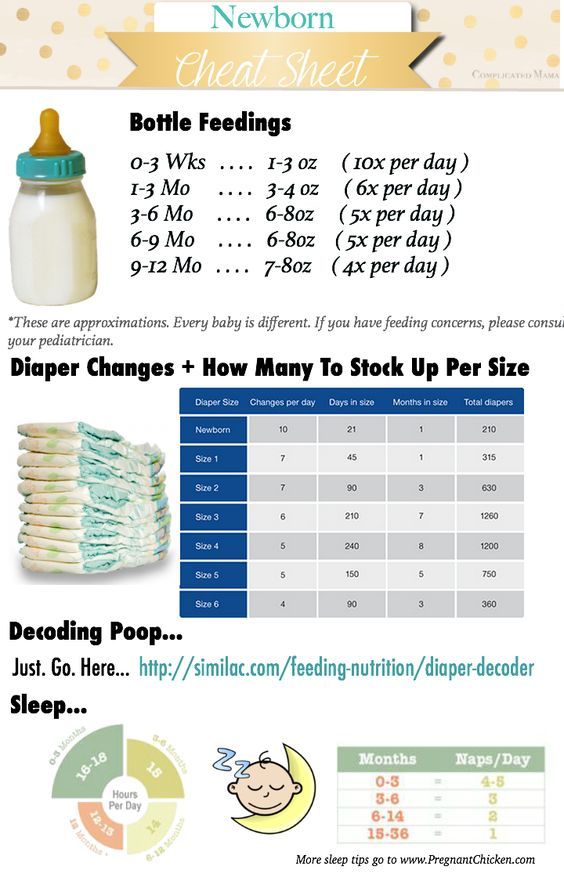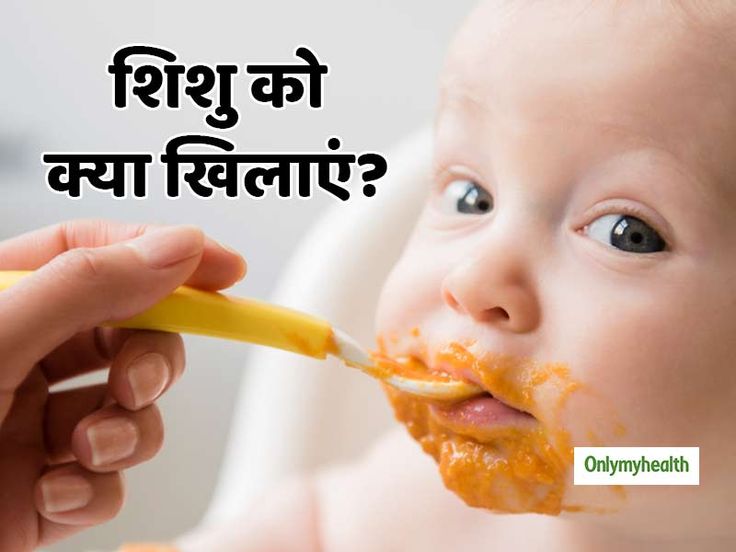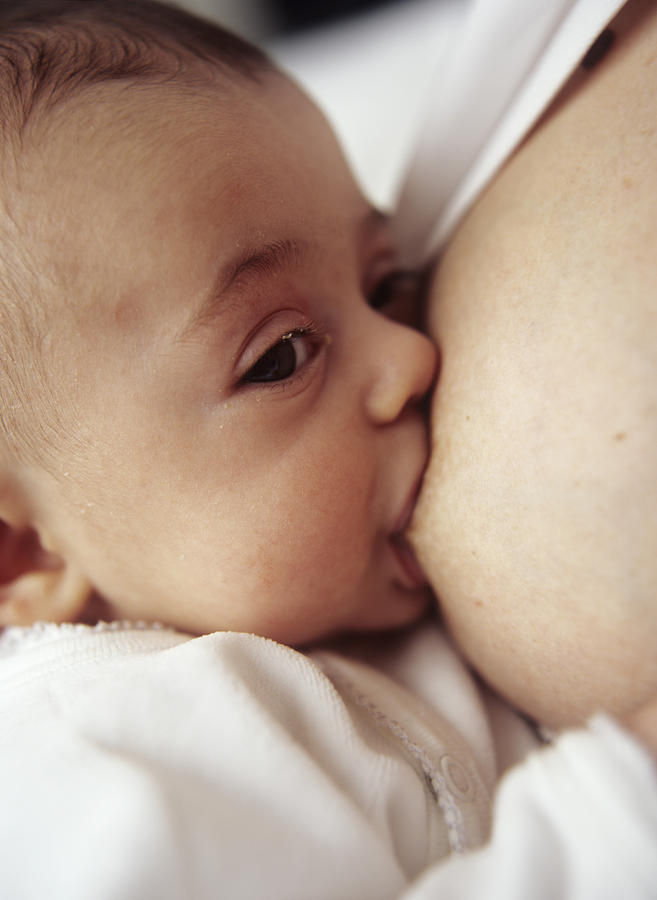Best first finger foods baby
Best Early Finger Foods for Baby (With Tips, Visuals, and Recipes)
Use this list of safe, nutritious, and easy to eat finger foods for baby to help you know exactly what (and how) to offer at meals and snacks. Plus, find the best first finger foods, troubleshooting tips, and visuals of foods broken down by food group to keep things easy!
Finger Foods for Baby
After baby starts solids and is ready to move onto finger foods, you may feel a little confused by exactly what to serve and how to serve it. Which is totally normal because it can be scary to let baby feed themselves this way and we may not have any experience doing this—or we may have totally forgotten from our last kiddo!
This list of finger foods for baby will cover some great first finger foods to start with, then set you up with plenty of healthy options from each food group.
TIP: Find more info on starting solids here and the best foods to start with if doing baby led weaning or purees with baby.
Healthy Baby Food
I love sharing these ideas for baby food since they are easy to prepare and serve and because I know how hard it can be to continue to come up with flavorful and healthy meals and snacks for our little ones. Let me tell you, I’m on my third kiddo and it can be such a challenge to feed him during the chaos of parenting the rest of my crew! These foods are wholesome and nutritious—perfect for your baby.
TIP: I’m a big fan of SpoonfulONE, a company that offers the most complete way to introduce food allergens to our kids. They make mix-ins, puffs, and crackers that are yummy and easy for babies and toddlers to eat. Learn more about their pediatrician-approved baby foods here. (sponsored link)
Best First Finger Foods
When baby is around 9 months, you’ll notice that they’re able to pick up smaller pieces of food with two fingers. This is known as the “pincer grasp” and is a sign that they’re ready to start finger foods. To be clear, when I say “finger foods” I mean small pieces of food that a baby (or toddler) can feed themselves.
To be clear, when I say “finger foods” I mean small pieces of food that a baby (or toddler) can feed themselves.
Here are some of my favorite ones to start with that are all super soft, safe to eat, and easy to pick up.
- Scrambled egg, broken up into small pieces
- Roasted sweet potato mashed and broken up into small pieces
- Fresh raspberries, broken up into smaller pieces
- Oatmeal, cooked according to package directions and allowed to cool
- Tofu, diced and sauteed lightly or steamed
- Ground beef, chicken, or turkey, broken up into small pieces or lightly mashed meatballs
- Shredded cheese or crumbled goat cheese
- Mashed sweet potato, in little pieces
- Peanut butter puffs
TIP: You can serve the tofu, ground meat, or meatballs in veggie puree from a pouch or a simple marinara sauce for extra moisture and flavor. Learn more about how and why to introduce peanut butter.
Finger Foods for Baby: Fruits and Veggies
Some of my favorite early fruits and veggies to serve babies are:
- Mashed roasted sweet potato, broken up into small pieces
- Warmed frozen peas, slightly mashed if desired
- Roasted Zucchini
- Diced Roasted Sweet Potato or Butternut Squash
- Fresh blueberries, cut in half or quarters
- Fresh raspberries, broken into small pieces
- Banana, broken into small segments (they are less slippery this way versus slicing them)
- Avocado, diced and mashed slightly (be sure it’s ripe and very soft)
TIP: A good rule of thumb is to serve pieces of food that are about the size of a pea to start and soft enough that they are easy to squish between your fingers.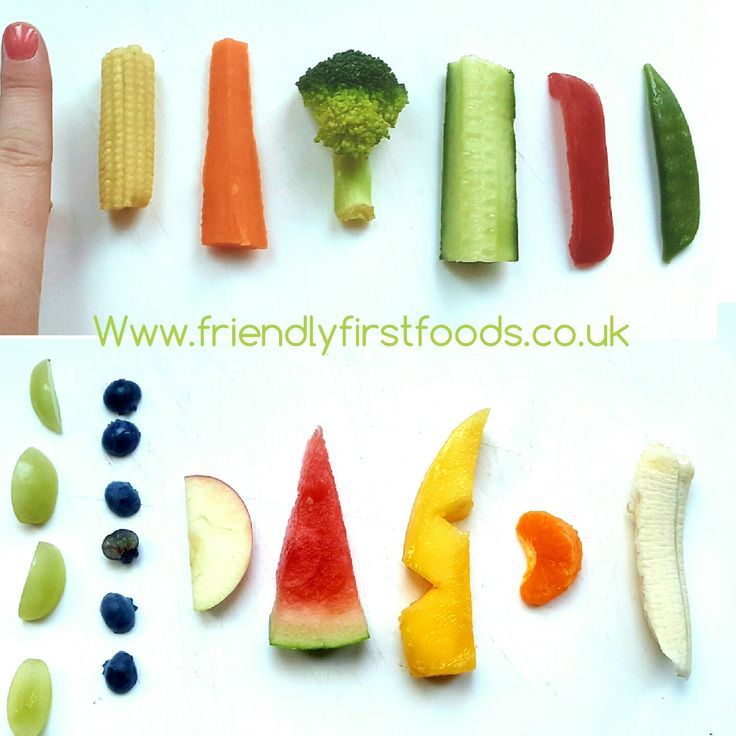 This will be easy for baby to pick up and eat and will also reduce chances of choking.
This will be easy for baby to pick up and eat and will also reduce chances of choking.
Finger Food Ideas: Carbohydrates
Offering complex carbohydrates can provide fiber, a variety of textures, B vitamins, and more. Try these with your baby.
- Spinach pancakes (moisten with applesauce or plain yogurt if needed; this recipe is particularly moist and great for babies)
- Oatmeal, cooked according to package directions and allowed to cool
- Baby Puffs
- Peanut Butter Puffs
- Rice (it’s easiest if it’s in little clumps so baby can pick it up; this Coconut Rice or this Cheesy Rice are both good options)
- Baby Banana Muffin
- O cereal (soften in nondairy unsweetened milk or yogurt as needed)
- Baked Oatmeal, diced
Finger Food Ideas: Proteins
Offering proteins will continue to expose baby to a range of nutrients. These are my go-tos for babies newer to finger foods—and toddlers too.
- Shredded cheese (thicker cuts are a little easier to pick up)
- Tofu, diced and sauteed lightly or steamed
- Flaked cooked wild salmon
- Lightly mashed meatballs
- Shredded chicken, cut up finely (we love this Butter Chicken to share with baby)
- Ground beef, turkey, or chicken, broken into smaller pieces
- Lightly mashed beans
- Scrambled eggs, broken up into small pieces
- Diced egg muffins
I’d love to hear any questions you may have, or if you have foods that your babies enjoy that I didn’t include here.
 Chime in below in the comments!
Chime in below in the comments!Prep Time 5 minutes
Cook Time 5 minutes
Total Time 10 minutes
Author Amy Palanjian
Cuisine American
Course Baby Food
Calories 124kcal
Servings 1
First Finger Foods (choose 1-3 per meal)
- ▢ 1 Scrambled egg (broken up into small pieces)
- ▢ 1/4 cup Roasted sweet potato, mashed and broken up into small pieces
- ▢ 1/4 cup Fresh raspberries (broken up into smaller pieces)
- ▢ 1/4 cup Oatmeal (cooked according to package directions and allowed to cool)
- ▢ 2 tbsp Tofu (diced and sauteed lightly or steamed)
- ▢ 2 tbsp ground beef, chicken, or turkey, broken up into small pieces or lightly mashed meatballs
- ▢ 2 tbsp shredded cheese or crumbled goat cheese
- ▢ 1/4 cup Mashed sweet potato (broken into little pieces)
- ▢ 1/4 cup Peanut butter puffs
Fruits and Veggies
- ▢ 1/4 cup mashed roasted sweet potato (broken up into small pieces)
- ▢ 1/4 cup warmed frozen peas
- ▢ 1/4 cup Roasted Zucchini
- ▢ 1/4 cup diced Roasted Sweet Potato or Butternut Squash
- ▢ 1/4 cup blueberries (cut in half or quarters)
- ▢ 1/4 cup raspberries (broken into small pieces)
- ▢ 1/4 cup banana slices (broken into small segments—they are less slippery this way versus slicing them)
- ▢ 2 tbsp avocado (diced and mashed slightly—be sure it's ripe and very soft)
Whole Grains and Carbohydrates
- ▢ 1 Spinach pancakes (moisten with applesauce or plain yogurt if needed; this recipe is particularly moist and great for babies)
- ▢ 1/4 cup Oatmeal (cooked according to package directions and allowed to cool)
- ▢ 1/4 cup Baby Puffs
- ▢ 1/4 cup Peanut Butter Puffs
- ▢ 1/4 cup fully cooked rice (it's easiest if it's in little clumps so baby can pick it up; this Coconut Rice or this Cheesy Rice are both good options)
- ▢ 1 Baby Banana Muffin
- ▢ 1/4 cup O cereal (soften in nondairy unsweetened milk or yogurt as needed)
- ▢ 1/4 cup Baked Oatmeal (diced or regular oatmeal broken into little pieces)
Dairy
- ▢ 2 tbsp Shredded cheese (such as mozzarella)
- ▢ 2 tbsp Tofu (diced and sauteed lightly or steamed)
- ▢ 2 tbsp flaked cooked wild salmon
- ▢ 1 lightly mashed meatballs
- ▢ 2 tbsp finely shredded chicken (we love this Butter Chicken to share with baby)
- ▢ 2 tbsp ground beef, turkey, or chicken (broken into smaller pieces)
- ▢ 2 tbsp lightly mashed beans
- ▢ 1 Scrambled egg (broken up into small pieces)
- ▢ 1 Diced Egg muffins
For each meal or snack, choose 2-3 foods from a mix of food groups.
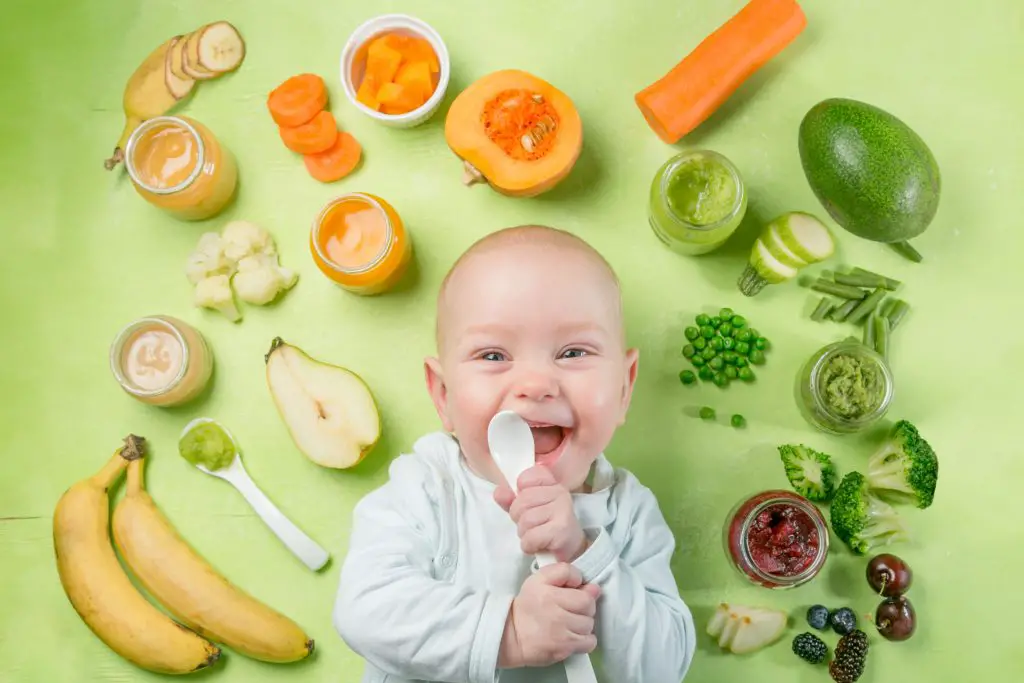 Aim to include some fat in most meals and protein in many too.
Aim to include some fat in most meals and protein in many too.Prepare the food, cutting into small pieces and/or mashing as needed to make the food easy to eat.
Start with small portions and allow more as baby indicates according to their hunger.
- Store leftovers in an airtight container for 3-5 days in the fridge.
- Many foods you cook for your family will work as baby finger foods—just be sure they are easy to squish between your fingers and the pieces are small and easy to chew.
- Babies very normally make a lot of faces when they eat, so don't assume they don't like something just because they scrunch their nose!
- Flavors and textures can take time to learn to eat, so continue offering foods in small portions even if baby hasn't liked them in the past—and make sure they taste good to you!
Calories: 124kcal, Carbohydrates: 14g, Protein: 7g, Fat: 4g, Saturated Fat: 1g, Polyunsaturated Fat: 1g, Monounsaturated Fat: 2g, Trans Fat: 1g, Cholesterol: 164mg, Sodium: 81mg, Potassium: 344mg, Fiber: 4g, Sugar: 5g, Vitamin A: 9857IU, Vitamin C: 18mg, Calcium: 51mg, Iron: 1mg
Tried this recipe?Rate in the comments and tag @yummytoddlerfood on IG!
Easy, Healthy, Perfect for Kids and Babies!
These sweet Banana Spinach Pancakes are a favorite when you’re looking to boost nutrition in a favorite breakfast option.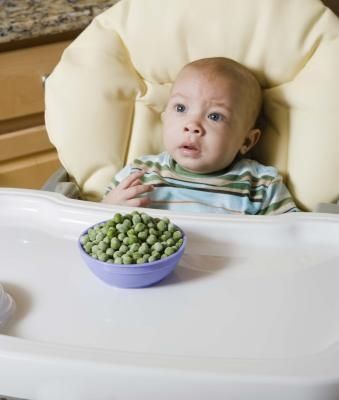 Or to have a little fun at the breakfast table by serving up a colorful meal.
Or to have a little fun at the breakfast table by serving up a colorful meal.
Spinach Pancakes
I never thought that my older daughter would be such a fan of green pancakes, but just when you think you know your kiddo, they go and surprise you! It turns out that she’ll eat pretty much anything in pancake form. This (and Spinach Pesto and my Spinach Muffins) are by far her preferred ways to get her greens.
I love how these are both easy to make and they’re so easy for the kids to enjoy.
The beauty of this kids pancake recipe is that it comes together in the blender so you don’t have to dirty a sink full of dishes to make it happen.
And it includes two bananas and small pile of spinach, so everyone will get a nice amount of vitamins and minerals to start the day.
TIP: The flavor is sweet, so despite the color, they taste like healthy banana pancakes.
Ingredients You Need
To make this simple pancake recipe you’ll need:
- Very ripe bananas: Those with brown spots will have the best flavor
- Eggs
- Buckwheat flour or whole wheat flour
- Milk: Dairy or nondairy
- Baby spinach: You can use fresh spinach or spinach that you’ve frozen
- Ground flaxseed
- Baking powder
- Cinnamon
- Vanilla extract,
- Oil or butter for cooking
Ingredient Substitutions
Both whole wheat and buckwheat flour work well in this recipe, though the pancakes cook through more easily with buckwheat. Look for it in the natural flours section of your supermarket. It’s widely available and very nutritious. For tips on using whole wheat flour, see the Notes section at the bottom of the recipe as you’ll want to reduce the milk amount slightly.
Look for it in the natural flours section of your supermarket. It’s widely available and very nutritious. For tips on using whole wheat flour, see the Notes section at the bottom of the recipe as you’ll want to reduce the milk amount slightly.
Use an egg replacer like the one from Bob’s Red Mill to make these egg-free.
Use buckwheat flour to make these gluten-free.
Use nondairy milk to make these without dairy.
Step-by-Step Instructions
Here’s a look at how to make these healthy pancakes. Scroll down to the bottom of this post for the full information.
- Add all ingredients to a blender except the flour.
- Blend, starting on low and working up to high. You want the spinach to be very well incorporated.
- Stir or pulse in the flour. Avoid over-blending but do make sure to get all of the flour blended in.
- Cook as you would any other pancakes and serve warm.
TIP: I like to cook these in a nonstick skillet or griddle since they are easiest to flip.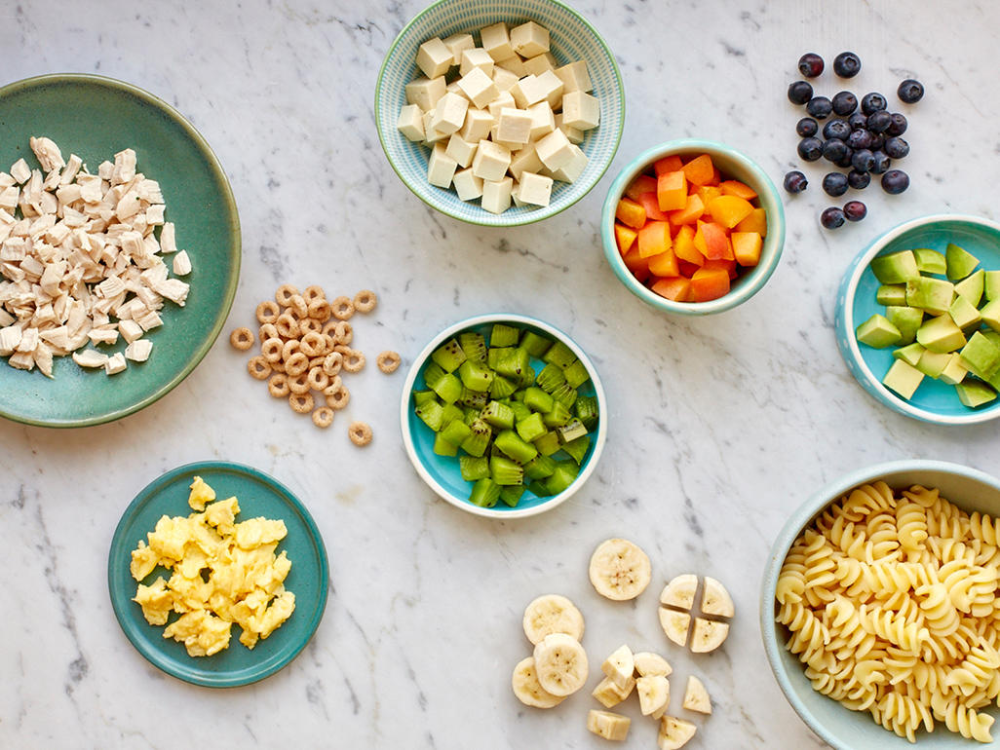 Cast iron also works if well greased.
Cast iron also works if well greased.
Gluten-Free Spinach Pancakes
Yes! Buckwheat flour is naturally gluten-free and it works well in this recipe.
Dairy-Free Spinach Pancakes
To make these dairy-free, simply use nondairy plain unsweetened milk instead of dairy milk and cook with neutral oil.
Easy Baby Pancakes
Due to the very soft texture of these pancakes, they tend to be much easier for babies to eat than traditional ones. And since they are packed with nutrients, this is a favorite pancake recipe to make for baby led weaning and once a baby is starting to eat finger foods.
TIP: Find my favorite early finger foods for babies here.
Serving Suggestions
Maple syrup and butter of course, or nut butter, yogurt, applesauce, chopped fruit, or jam are all good options. When my middle kiddo was a baby, she ate them plain!
TIP: We like to have ours with a fruit salad rainbow (without the pot of gold at the end, unfortunately!) for St. Patrick’s Day, but that part is of course optional.
Patrick’s Day, but that part is of course optional.
How to Store
These store really well if you let any leftovers cool and store in an airtight container or zip top freezer bags. You can store leftovers in an airtight container in the fridge for 3-5 days or in a freezer safe container or bag for up to 3 months. Warm in 15 second increments in the microwave to serve.
Tips for Making the Best Spinach Pancakes
- You can store a bag of baby spinach in the freezer to use in smoothies and pancakes. Freezing it maintains the nutrients but it knocks out any “green” flavor which is handy! It’s also nice that you don’t have to worry about it going bad before you can use it up.
- Be sure to blend the batter very smooth to get the greens very well processed.
- You can sub in whole wheat flour for the buckwheat, but you’ll want to reduce the milk by ¼ cup.
- If the bottoms start to brown too much before they are set, lower the heat to medium-low.
- Look for buckwheat in the natural flours section of your supermarket.
 It’s widely available and very nutritious.
It’s widely available and very nutritious. - If making for a baby who’s not yet consuming cow’s milk, you can use unsweetened nondairy milk.
- I prefer to use a nonstick skillet or griddle for this recipe, though cast iron works too.
- You may also like Spinach Banana Muffins, 2-Ingredient Pancakes, Banana Oatmeal Pancakes, and Yogurt Pancakes.
I’d love to hear what you think of this recipe so please comment below with feedback!
This post was first published March 2018.
Prep Time 5 minutes
Cook Time 15 minutes
Total Time 20 minutes
Author Amy Palanjian
Cuisine American
Course Breakfast
Calories 237kcal
Servings 4
- ▢ 2 small very ripe bananas (about 1 cup tightly packed sliced banans)
- ▢ 2 large eggs
- ▢ 1 cup buckwheat flour or whole wheat (See Notes at the bottom if using whole wheat)
- ▢ 1 cup milk
- ▢ 2 cups lightly packed baby spinach
- ▢ 1 tablespoon ground flaxseed
- ▢ 1 1/2 teaspoons baking powder
- ▢ 1 teaspoon cinnamon
- ▢ 1 teaspoon vanilla extract
- ▢ Coconut oil for cooking (or canola oil or butter)
Add all ingredients to a blender except the flour.
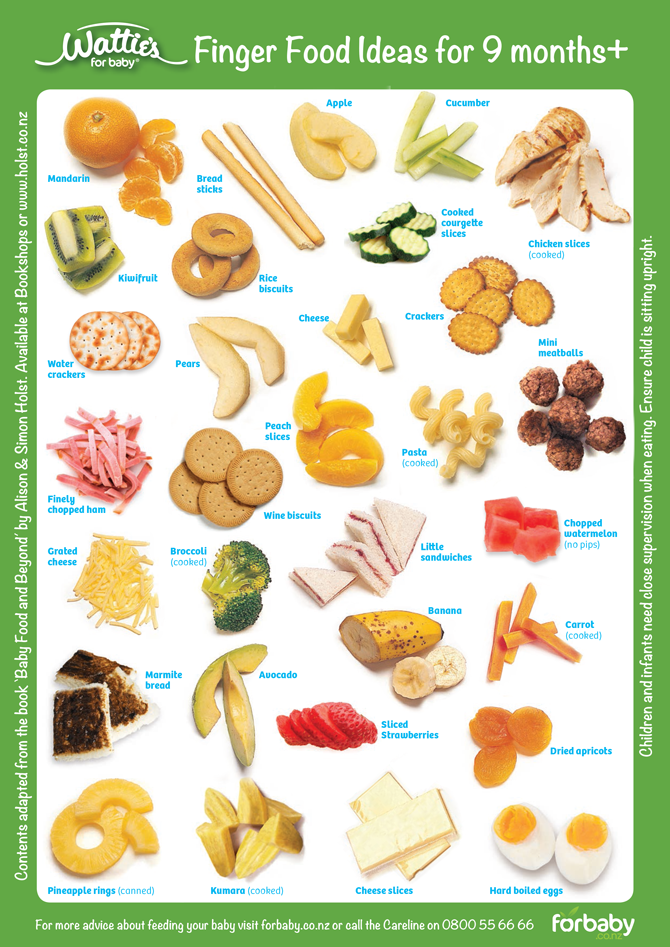
Blend on high until very well combined, about 20-30 seconds, or until you no longer see any noticeable flecks of spinach.
Stir or pulse in the flour and thoroughly combine without over-mixing.
Warm a nonstick or cast iron skillet or griddle over medium heat and coat with oil or butter. Pour small rounds of batter onto the hot surface—the batter should spread fairly thinly on its own—and let cook until bubbles form on the surface and the surface is mostly set, about 3-4 minutes.
Flip and cook for an additional 3 minutes, or until fully cooked.
Continue to prepare the rest of the batter, keeping the finished pancakes warm in a 275 degree oven if desired.
Serve warm with fruit, maple syrup, or another favorite dip.
Green Pan Non-Stick Pan
Vitamix Blender
Spatula
- To store, let cool fully and keep in an airtight container in the fridge for up to 3 days.
 Warm slightly before serving. Or, store in a zip top freezer bag for up to 3 months and warm through to serve.
Warm slightly before serving. Or, store in a zip top freezer bag for up to 3 months and warm through to serve. - Whole-wheat flour: You can sub in whole wheat flour for the buckwheat. Just reduce the milk to ¾ cup.
- You can use baby kale in this recipe if you prefer.
- You can store a bag of baby spinach in the freezer to use in smoothies and pancakes. Freezing it maintains the nutrients but it knocks out any “green” flavor which is handy! It’s also nice that you don’t have to worry about it going bad before you can use it up.
- Be sure to blend the batter very smooth to get the greens very well processed.
- If the bottoms start to brown too much before they are set, lower the heat to medium-low.
- Look for buckwheat in the natural flours section of your supermarket. It’s widely available and very nutritious.
- If making for a baby who’s not yet consuming cow’s milk, you can use unsweetened nondairy milk.
- I prefer to use a nonstick skillet or griddle for this recipe, though cast iron works too.

Calories: 237kcal, Carbohydrates: 40g, Protein: 9g, Fat: 6g, Saturated Fat: 2g, Polyunsaturated Fat: 1g, Monounsaturated Fat: 2g, Cholesterol: 104mg, Sodium: 206mg, Potassium: 577mg, Fiber: 6g, Sugar: 11g, Vitamin A: 1674IU, Vitamin C: 9mg, Calcium: 208mg, Iron: 2mg
Tried this recipe?Rate in the comments and tag @yummytoddlerfood on IG!
what products are possible, features of complementary foods
It is no secret that young and not very experienced mothers receive information on the nutrition of an infant, including recommendations on how to introduce the first complementary foods, mainly from two sources: grandmother's stories and from the Internet. Unfortunately, both of these respected sources of information may voluntarily or not voluntarily, but be very mistaken, since grandmothers grew up in a more prosperous time in terms of environmental conditions, and the Internet is littered with various articles that are rarely written by professionals, moreover, they rely either on explicit outdated guides on baby food, or frankly on unverified information.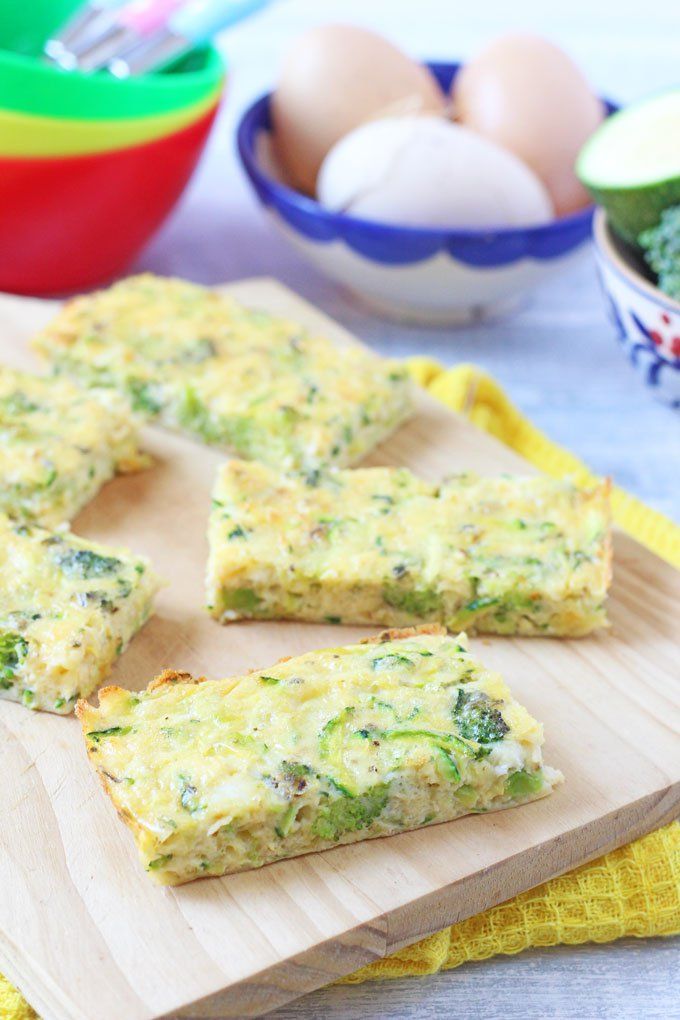
In this article, I will try to combine the latest scientific data and recommendations on how to introduce the first complementary foods with many years of observations from the experience of a practical pediatrician and an allergist-immunologist.
At what age is it time to introduce the first complementary foods
According to the recommendations of the Research Institute of Nutrition of the Russian Academy of Medical Sciences, the first complementary foods can be introduced from 4.5 - 5 months, regardless of the type of feeding. This is "average". In practice, the choice of when to start introducing complementary foods still depends on the individual characteristics of the child. For example, for a child with widespread atopic dermatitis (diathesis), we will not introduce complementary foods until at least acute skin symptoms, such as cracks, weeping or secondary eczema, have steadily disappeared. Increased dryness and flaking of the skin, of course, require constant application of moisturizers to the skin, but in no case are they a contraindication to the start of the introduction of the first complementary foods.
Another important point when choosing the time to start introducing complementary foods is the dynamics of the child's weight gain. The more intensively the child gains in height and weight, the sooner he may need additional calories, since the energy value of breast milk or artificial formula alone will most likely not be enough for a child who grows faster than his peers by 4 - 5 months. We must not forget that natural products contain a fairly large range of minerals and vitamins, and a mother’s body, alas, cannot be an eternal and bottomless source of useful nutrients, somewhere something will gradually begin to be missed.
In addition, the nature of lactation in the mother has a great influence on the timing of the introduction of complementary foods. If a nursing mother begins to feel a lack of milk, I would prefer to first give her advice on stimulating lactation, and at the same time begin to introduce complementary foods. It will be better than introducing an artificial mixture. But I repeat that the earliest start date for the introduction of the first complementary foods is the age of 4 months, before the child's body is not yet ready, the risk of developing allergies is also high.
But I repeat that the earliest start date for the introduction of the first complementary foods is the age of 4 months, before the child's body is not yet ready, the risk of developing allergies is also high.
So, we agree with you that the first complementary foods can be introduced no earlier than 4 months of a child's life.
First complementary foods: Which foods to choose?
The first complementary foods, as a rule, should consist of vegetable or fruit purees, but in no case juices. Still, juices, even for children, are highly filtered, mainly contain a large amount of organic acids and “light” carbohydrates (that is, sugar, to make it clear to everyone). I will not waste time explaining why juices are harmful to an infant, but I will describe a clinical case from practice.
Parents with an 8-month-old girl came to the reception. Somewhere from 5 months she practically did not gain weight, although before that all indicators were normal. In the analyzes, apart from visible signs of iron deficiency, slightly reduced hemoglobin, no pathology was also detected. The main complaint: "does not eat anything." And when I began to find out what she still eats, it turned out that the child drinks half a liter of juice every day. But porridge or cottage cheese, or mashed potatoes cannot be forced together, they spit everything out. I don't like the taste. And so - for three months. The child, of course, became very nervous, yelling at night, demanding juice.
The main complaint: "does not eat anything." And when I began to find out what she still eats, it turned out that the child drinks half a liter of juice every day. But porridge or cottage cheese, or mashed potatoes cannot be forced together, they spit everything out. I don't like the taste. And so - for three months. The child, of course, became very nervous, yelling at night, demanding juice.
So draw your own conclusions and be careful.
For the first feeding, this is now recognized by everyone, the best dishes are vegetable purees from green varieties of vegetables: zucchini, cauliflower, broccoli. The first complementary foods are introduced, starting with half a teaspoon, in the morning for three days, then gradually increase the amount of the product to 40-50 grams per week. Supplemented with breast milk or formula.
For problems with stools, constipation, it’s good to start introducing prune puree, green apple, you can try pumpkin, even apricot puree, but in no case start with carrots.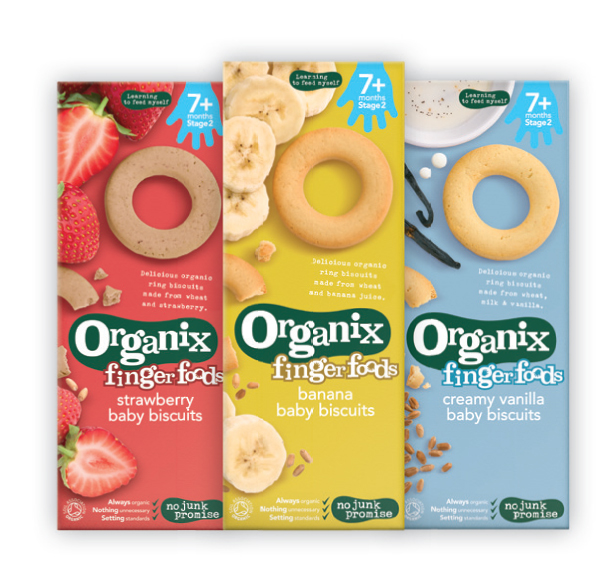 Beta-carotenoids, which are abundant in carrots, are generally poorly absorbed and can cause allergies in a child.
Beta-carotenoids, which are abundant in carrots, are generally poorly absorbed and can cause allergies in a child.
Second food. Porridge or meat?
Even 5 - 6 years ago, we taught students at the medical institute that from 5 - 5.5 months old, an infant should begin to give cereal porridge for complementary foods. This is rice, buckwheat, corn. The first week you can cook 5% porridge: 5 grams of ground cereal per 100 ml of water. Then the porridges are cooked already denser: 10 grams of cereal per 100 ml of water. But now, basically everyone uses instant (soluble) cereals, which are diluted with water according to the instructions on the package. In addition, ready-to-eat liquid cereals are on sale: for example, Bellakt, Frutonyanya, etc.
Why meat? You ask. According to modern recommendations (they really began to change quite often), but in this case I support: if a child has a pronounced decrease in hemoglobin in the blood below 100 g / l by the age of 5 months, it makes sense to start introducing fruit or vegetable purees as a second types of complementary foods - meat purees as a source of the most well-absorbed heme iron.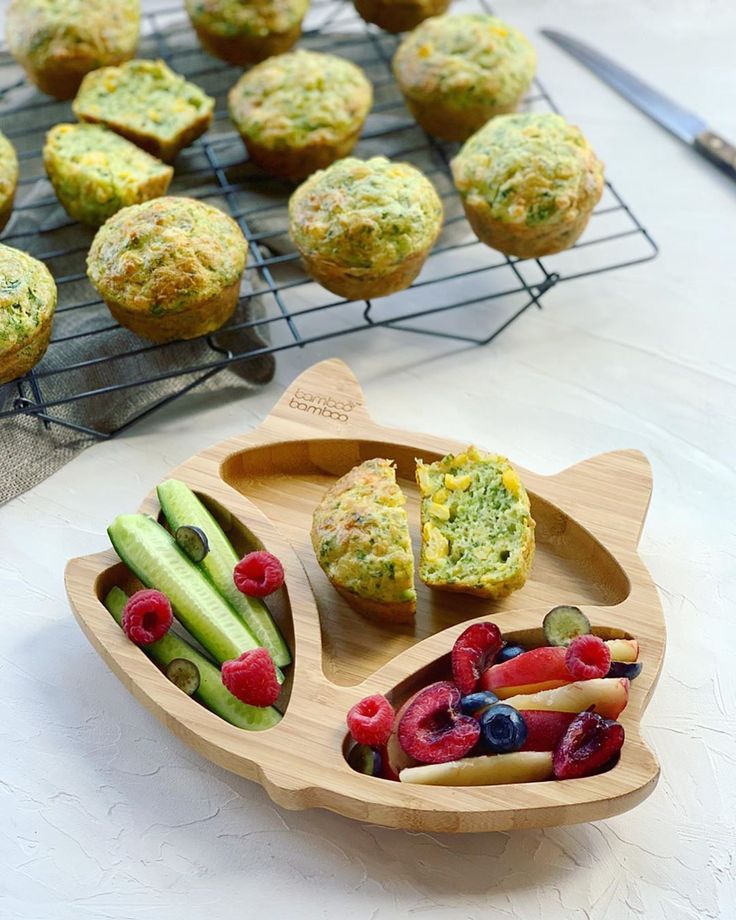 You need to choose from varieties such as turkey, rabbit, lamb. Beef and veal can only be offered to children who did not have red cheeks and diathesis.
You need to choose from varieties such as turkey, rabbit, lamb. Beef and veal can only be offered to children who did not have red cheeks and diathesis.
In the absence of problems with low hemoglobin, feel free to introduce porridge as the second meal of complementary foods, especially if the child is small and does not gain weight very well. In this case, we can recommend breeding cereals with the addition of breast milk or a mixture (Nan, Nutrilon, Celia, Nanny). With mixtures based on goat's milk, parents of children with a predisposition to allergies should be very careful. Goat milk formulas are not the best choice for babies who are allergic or intolerant to cow's milk protein, whatever the internet says. Believe me, there are serious scientific articles by foreign authors, which provided data on a very high frequency of cross-allergy between cow and goat milk proteins in children who were transferred to goat milk mixtures. And I saw it myself in my practice, when a child with dermatitis was transferred to a mixture of goat's milk, there was a clear improvement for a month or two, and then all over again and with a doubled degree of allergic skin damage.
Introduction to fermented milk products
This is the most difficult question. I am sure that most of our grandparents demand that their stupid parents start drinking milk and kefir as soon as possible. In a number of cases, children really start to absorb sour-milk products quite well after 6 months, but before this age I am very careful even with sour-milk Agusha, and even introducing milk or kefir before 6 months is a bad form, believe me, and can lead to very bad consequences for the child. I understand the Western European medical community, which has recently banned its pediatricians from recommending fermented milk products for complementary foods for children under 3 years of age, just imagine!
They (the Europeans) need to do something with their artificial milk mixtures. Even 20 years ago, we did not know other mixtures after the "two", that is, the second formula for children from 6 to 12 months. Then there were formulas for children from 1 to 2 years old, then from 2 to 3 years old, and now there are already mixtures for children up to 4 years old, and I think if this goes on, then until the age of sixteen there will be their own milk substitutes.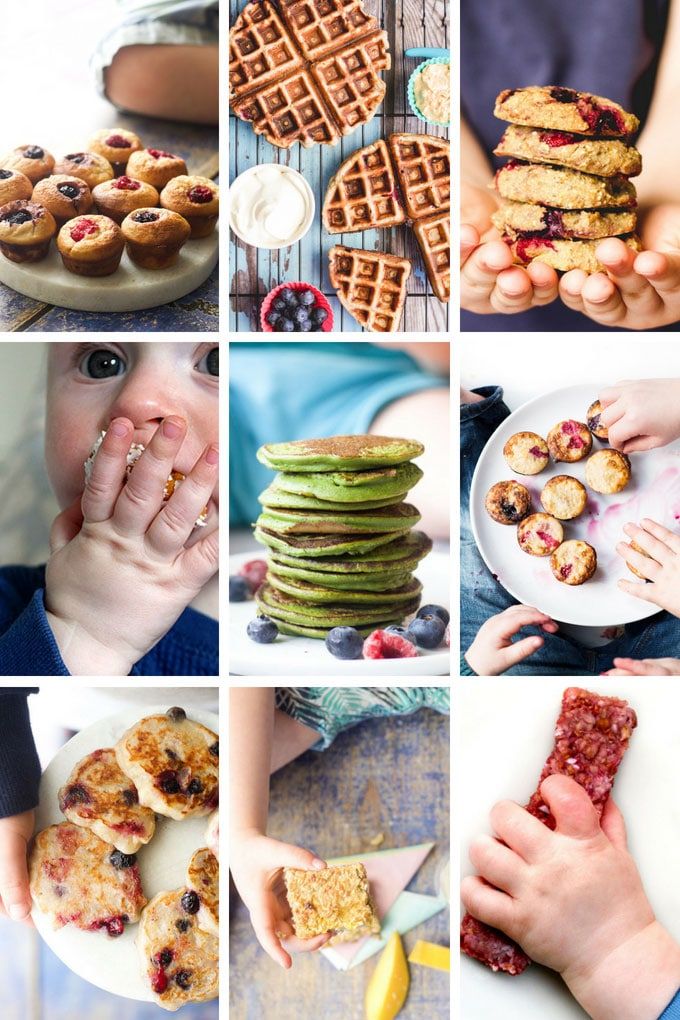 Dismiss me, I don't think this approach is correct. But the fact is that our grandparents had much better genetics than the generation of our children, alas. In the context of the growth of medical capabilities, genetically determined diseases are also growing, and in this case, intolerance to cow's milk protein, and with every 10 years there are more and more such people among us. But if a child really suffers from an allergy to cow's milk protein or is severely deficient in enzymes, then he will carry this peculiarity through his whole life, and most likely he will not drink milk or kefir himself, and there is no need to force him if he himself won't want to!
Dismiss me, I don't think this approach is correct. But the fact is that our grandparents had much better genetics than the generation of our children, alas. In the context of the growth of medical capabilities, genetically determined diseases are also growing, and in this case, intolerance to cow's milk protein, and with every 10 years there are more and more such people among us. But if a child really suffers from an allergy to cow's milk protein or is severely deficient in enzymes, then he will carry this peculiarity through his whole life, and most likely he will not drink milk or kefir himself, and there is no need to force him if he himself won't want to!
But you are lucky with genetics, and no one in the family has ever had an allergy (which is hard to imagine nowadays), and most importantly, if your child has always had perfectly clean skin, then the first of the dairy products - cottage cheese, you will begin to offer your child with 7 months, kefir - from 10 months. Milk - after a year. It will be better this way.
Milk - after a year. It will be better this way.
But if your family does not have a very close and joyful relationship with milk, then it is better to postpone even the introduction of kefir and yogurt into complementary foods for a child until the age of 18 months.
Fish day and first meal
Fish is a very healthy product, rich in vitamins and antioxidants, but it must also be introduced carefully. I advise you to start introducing the first fish food at about 7-8 months. It is better to start with species such as cod, hake, haddock. The rules are the same: the first three days on the "gram," then slowly add. If there are no problems in a week or two, you can try such delicacies as tuna or salmon, of course, canned children, if you can find it. It is better not to mess with trout and salmon in the first year of life, this fish is all stuffed with dyes and antibiotics.
No matter how hard I tried, the article about the first complementary foods turned out to be long.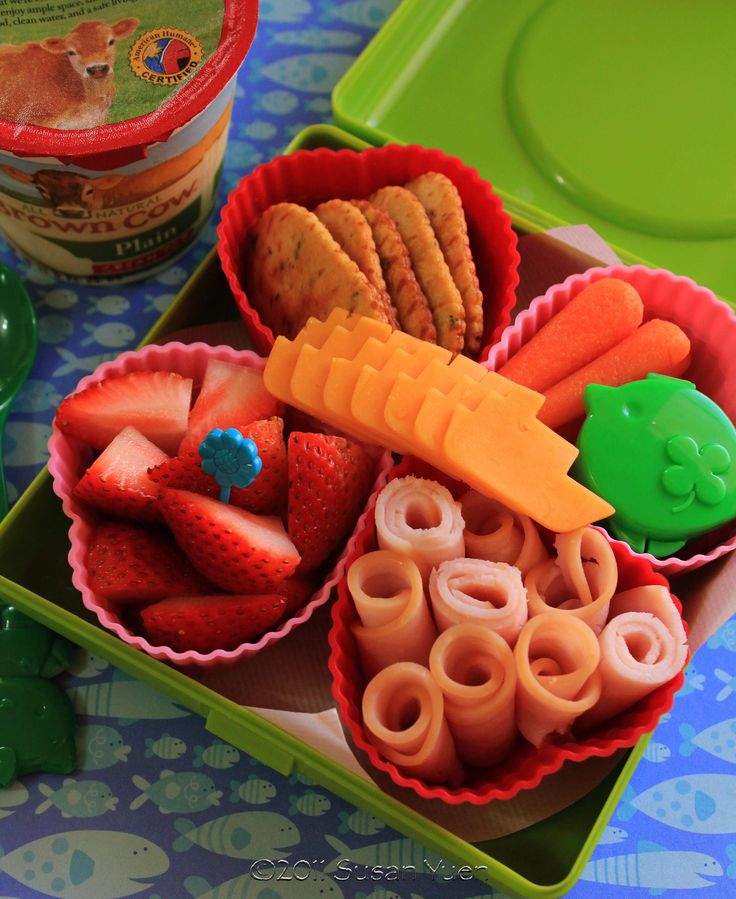 Thank you for reading to the end, I hope it will be useful. If you have questions about the introduction of complementary foods, you can write your appeals on our website in the question to a specialist section. A short answer can be obtained on the Internet, but in order to make a diagnosis and give a detailed consultation, of course, you need to come to a face-to-face appointment with a pediatrician and a pediatric allergist.
Thank you for reading to the end, I hope it will be useful. If you have questions about the introduction of complementary foods, you can write your appeals on our website in the question to a specialist section. A short answer can be obtained on the Internet, but in order to make a diagnosis and give a detailed consultation, of course, you need to come to a face-to-face appointment with a pediatrician and a pediatric allergist.
10 Best First Food Purees - Ranking 2022
Introduction of complementary foods is a necessary procedure for many new parents. Puree from vegetables, fruits, fish or meat is introduced into the diet of crumbs at the age of 5-6 months, when the child's digestive system can already absorb the components of the puree. Before using the first complementary foods, it is imperative to consult a pediatrician. A review will also help in choosing, which presents the best purees for the first feeding, according to doctors, users and the experience of manufacturers.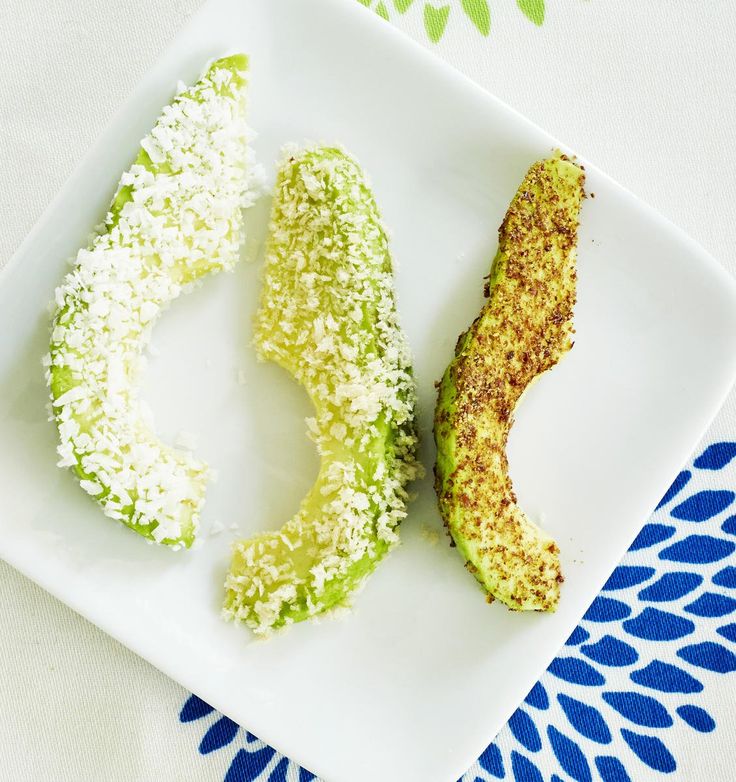
Content
How to choose puree for the first feeding
The readiness of the baby for the introduction of complementary foods is signaled by a doubling of body weight from the moment of birth, as well as the ability to eat while in an upright position. Then the question arises of which purees are better to buy for the first complementary foods. Pediatricians recommend starting with vegetable purees, as they lack fructose, which has an undesirable effect on the immature pancreas and kidneys.
Doctors advise choosing products from well-known trusted brands, as they are subject to a quality control procedure. Thus, when compiling a review of puree companies for the first complementary foods, the following factors were considered by specialists:
- Cost. The most expensive product does not mean the highest quality. The price is affected by the type of packaging, the cost of shipping raw materials - something that does not affect the content in any way;
- Composition.
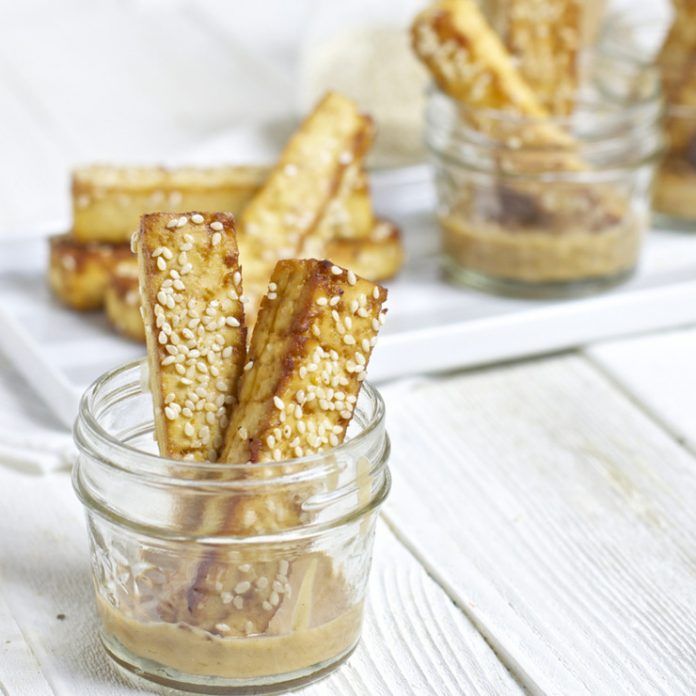 A quality product does not contain dyes, enhancers and preservatives, as well as spices;
A quality product does not contain dyes, enhancers and preservatives, as well as spices; - Hypoallergenic and product safety;
- The degree of grinding of the components;
- Age category.
Studying the question of what kind of baby food is best for complementary foods, we analyzed the opinions and experiences of parents left on major forums and social networks. This helped determine the most purchased brands, which are most trusted.
When buying baby puree, look at the integrity of the package, the lid should not be damaged, and when opening the package, there should be a popping sound, which confirms the freshness of the product. You should also find out the appropriateness of the selected food for the age of the child. The review presents foreign and domestic companies offering top quality products.
The best domestic purees for the first feeding
You can buy vegetable puree for the first feeding from Russian manufacturers. After analyzing more than a hundred reviews, we were able to select brands that are trusted by customers.
After analyzing more than a hundred reviews, we were able to select brands that are trusted by customers.
Russian manufacturers produce food for children at the highest level at a pleasant price, due to which the products are in demand among parents. Many companies produce products from natural raw materials of their own production. 5 domestic manufacturers were selected for the rating, which proved to be leaders in the quality of baby food and popularity among mothers and fathers.
Frutonyanya
This brand is one of the most famous, most parents choose the products of the Frutonyanya company. All products undergo special testing and are recommended by the Union of Pediatricians. Frutonyanya produces vegetable puree for the first feeding. The tightness of the packaging is ensured by a lid and a dense polyethylene film, which allows you to protect the container from the ingress of dirt and dust.
The company has a continuous production cycle. Fruits and vegetables from our own farms are processed, which is an indicator of the naturalness of the products. The manufacturer has released a line in doypack packaging, now you can take food for a walk.
The manufacturer has released a line in doypack packaging, now you can take food for a walk.
Advantages
- Free from salt and sugar additives;
- Quality testing;
- Low cost;
- The scale with divisions in grams allows you to see the amount of puree eaten by the baby;
- Availability of hypoallergenic series.
Drawbacks
- Not identified.
Consumer reviews report a low risk of allergic reactions after use, as the product does not contain preservatives. For buyers, an important condition is the experience of the manufacturer. Products are manufactured by factories that have specialized in baby food for decades.
Grandmother's basket
The company's products are not as advertised as Frutonyanya, but still in demand among many buyers. The puree complies with strict preservation purity conditions. In the manufacturing process, technologies are used to preserve the beneficial properties of products. The puree includes only boiled and pasteurized fruits and vegetables. The composition is the main ingredient and pure water.
The puree includes only boiled and pasteurized fruits and vegetables. The composition is the main ingredient and pure water.
Choice of mashed potatoes for the first meal of zucchini, broccoli and cauliflower. The company also produces fruit products. For older children, you can buy food from cod, pink salmon and salmon. The puree has the right consistency.
Advantages
- Free from food coloring and other additives;
- Possibility to buy in soft drinking packaging;
- Environmentally friendly components;
- Uniform consistency.
Drawbacks
- Unusual taste.
One-component purees of this brand are in special demand among buyers. They note a good consistency and the optimal amount of one serving. Not all parents like the smell of the product, but it does not interfere with children, and they eat mashed potatoes with great pleasure.
Diaper
Sady Pridonya recently launched this brand. The manufacturer produces nutritional formulas for children of different ages. The consumer can choose purees from fruits, vegetables or a combination. The product is presented in different containers - glass and cardboard.
The manufacturer produces nutritional formulas for children of different ages. The consumer can choose purees from fruits, vegetables or a combination. The product is presented in different containers - glass and cardboard.
The main ingredients are fruits and vegetables, while the crops are grown by the company. For the manufacture of products GMOs, dyes and preservatives are not used. The composition contains only natural products and water. And the quality of the indicators is controlled by the Russian Academy of Medical Sciences. The absence of expenses for the transportation of purchased raw materials allows us to reduce the cost, which cannot but attract.
Advantages
- Large selection of purees for babies from 4 months;
- Manufacture on high-precision equipment;
- Convenient packaging;
- Affordable rates.
Drawbacks
- Use of sugar for some types of puree.

Users are attracted by a large assortment. In addition to mashed potatoes, you can buy fruit drinks, juices and cereals. High demand for puree from several components. It can be fruits or berries with the addition of dairy products.
Topic
The Concern occupies a leading position among domestic manufacturers of baby food. Products are made using the latest equipment. The Tema brand offers compositions with fruits, vegetables, meat, combined variations. For complementary foods, vegetable compositions of zucchini, carrots and pumpkins are suitable.
In the manufacturing process, only natural and easily digestible vegetables are used, which normalize the functioning of the digestive system. In addition to purees, the company produces juices and fermented milk products.
Advantages
- Reasonable prices;
- High quality products;
- Huge assortment;
- Variety of packaging.
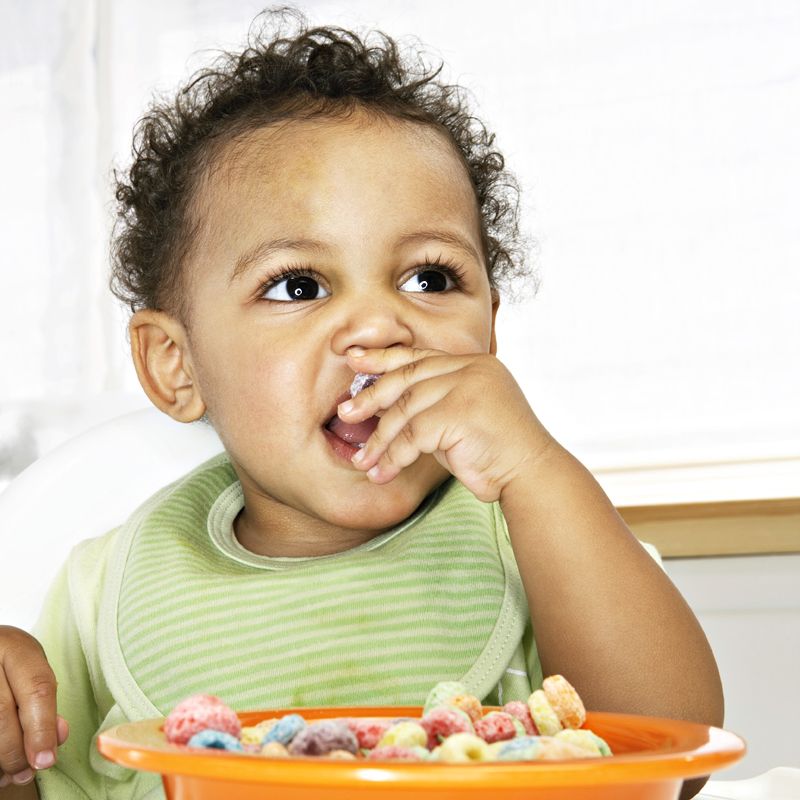
Drawbacks
- Small amount of starch.
Many people like that Tema puree can be bought both in the nearest store and in the pharmacy. Also noted is the ideal consistency, the absence of unnecessary inclusions. Vegetable puree has a pleasant smell and color. Often promotions are provided on Tema puree in supermarkets.
The best foreign purees for the first feeding
A certain range of foreign manufacturers is represented on the market. Some moms and dads tend to choose them, because many companies have an excellent reputation and centuries of history. The best purees for the first feeding from foreign brands in the review are represented by five positions.
The rating of baby puree supplied to the Russian market from abroad was built primarily on the basis of pediatricians' estimates. The quality of raw materials, nutritional properties, relevance of benefits for children living in our country were taken into account.
Gerber
Products from Nestle are known for their high quality and wide range, its laboratory is one of the best in Europe. For feeding babies, mashed potatoes with one component of vegetables are suitable. The product is distinguished by a fine fraction and an environmentally friendly composition. The Gerber brand also produces food for older children. And meat purees will help make complementary foods more varied. The light texture of meat is pleasant to kids.
The manufacturer also sells multi-component products. In one puree, vegetables and milk are combined, berries are also added, enriching the child's body with organic acids, minerals, and vitamins. In addition, Gerber provides desserts made from milk with fruits.
Advantages
- 4 vegetable purees;
- Products pass approximately 250 checks;
- Convenient single serving packaging;
- Special retractable caps.
Drawbacks
- Not identified.
Users love the manufacturer's packaging. Through the glass you can see the consistency and color of the dish. Jars have lids with a special ledge, which was developed by the company's specialists. Convenient flexible packaging pouch.
Semper
The Swedish brand produces baby food for newborns and preschool children. Not only mashed potatoes, but also cereals, juices and milk mixtures are offered to choose from. Semper offers four steps of complementary foods. For children from 4 months - monocomponent formulations. For crumbs from six months - meat mixtures and assorted fruits. Fish dishes - from 7 months. And the combination of meat and vegetables in one product is suitable for children from a year and older.
The composition does not contain thickeners and dyes, but only chopped vegetables and water. From Semper you can buy food for a snack on a walk, the first complementary foods and expanding the baby's menu.
Advantages
- The first stage contains homogenized vegetables;
- European quality level;
- Testing at every stage of production;
- Improved composition.
Drawbacks
- Small portion package not included.
Consumers believe that the brand does not offer such a high price in terms of volume. Zucchini with potatoes, zucchini with potatoes and broccoli are in special demand. There are no additional components in the vegetable mixture, except for a small amount of rice flour.
HiPP
The company has a large assortment of baby food. For the first feeding from 4 months, mixtures of zucchini, cauliflower, carrots, broccoli and pumpkin are suitable. From six months you can buy a jar of turkey, beef or rabbit meat.
Hipp canned products are distinguished by their natural composition. Mixes include chopped vegetables, fruits, meat. There is nothing else in the product except water. The contents of the jars have a thick consistency, without lumps. Food has a pleasant taste and smell. The company uses convenient, safe packaging with a bright design that children love so much.
Advantages
- Wide range for first foods;
- High quality;
- Choice of volume - 80 and 125 gr;
- Uniform consistency.
Drawbacks
- Expensive product.
With regular consumption of the product, parents noticed that the child's stool normalizes, the intestines begin to work stably. Healthy canned food is relevant in winter, when it is difficult to purchase fresh vegetables and fruits.
Heinz
A company from the USA delivers goods to different countries of the world. In the course of work, strict control systems, innovative equipment, and the latest advances in technology are used. The applied technologies allow keeping minerals and vitamins in the composition.
Heinz offers standard first food kits. In addition to vegetables, the composition contains cornmeal. This ingredient allows you to achieve a uniform consistency.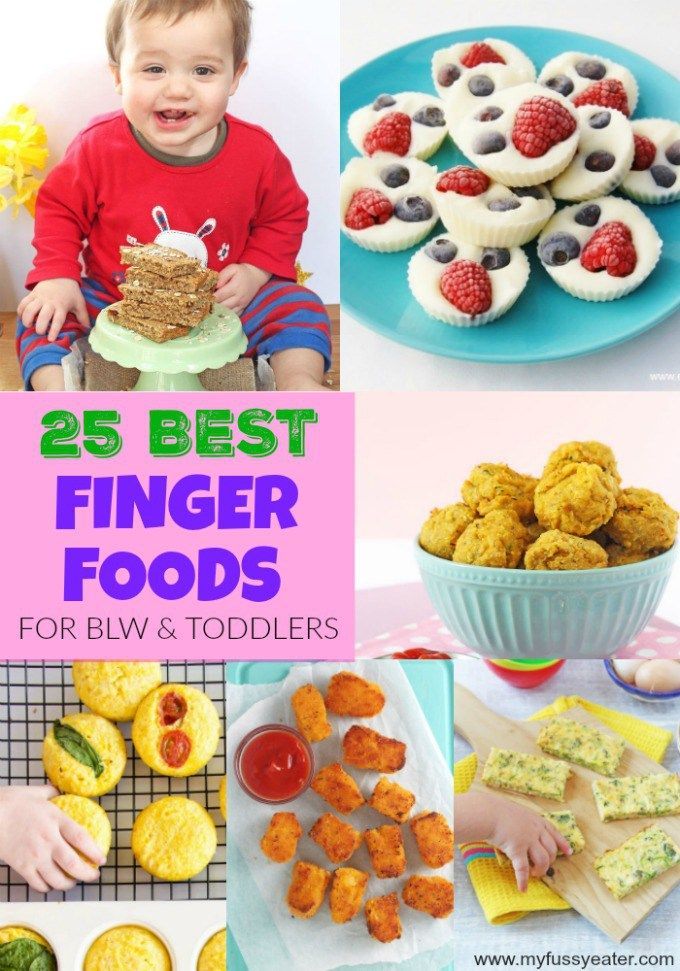 Delicious puree like most children. The company responsibly approaches the compatibility of various components in the formulations.
Delicious puree like most children. The company responsibly approaches the compatibility of various components in the formulations.
Advantages
- Meets stringent standards;
- Rich taste;
- Soft consistency;
- Large selection.
Drawbacks
- Not identified.
Heinz baby food is recommended by pediatricians to parents, as it contains minerals and vitamins that are important for the health of the child. Fiber stimulates the digestive system. Eating creates a feeling of satiety for a long period.
The company makes baby food with the best sugar-free ingredients. Only natural saccharides are present. The products are free of gluten, salt and flavors. The puree contains corn oil, which acts as a source of omega acids. And the use of rice flour provides a better consistency, it is also rich in amino acids and fiber.
Cauliflower, zucchini, broccoli or carrots are available as first foods. The age of the child is indicated on the package. The recipe complies with European standards regarding the nutrition of children. The products contain vitamins that are important for the full development of the crumbs.
The age of the child is indicated on the package. The recipe complies with European standards regarding the nutrition of children. The products contain vitamins that are important for the full development of the crumbs.
Advantages
- Soft consistency;
- The mixture is thoroughly ground;
- Contains useful components;
- Natural pleasant taste.
Drawbacks
- Presence in the composition of rice flour.
Parents note the good taste of baby food from Bebivita. As well as the use of safe products for the composition. Positive reviews are found about the quality of the packaging and the affordable price.
Which puree for the first feeding is better to buy
To find out exactly whether the baby is ready to introduce complementary foods, you need to consult with your doctor. It should not be ignored if the child refuses food and spits it out.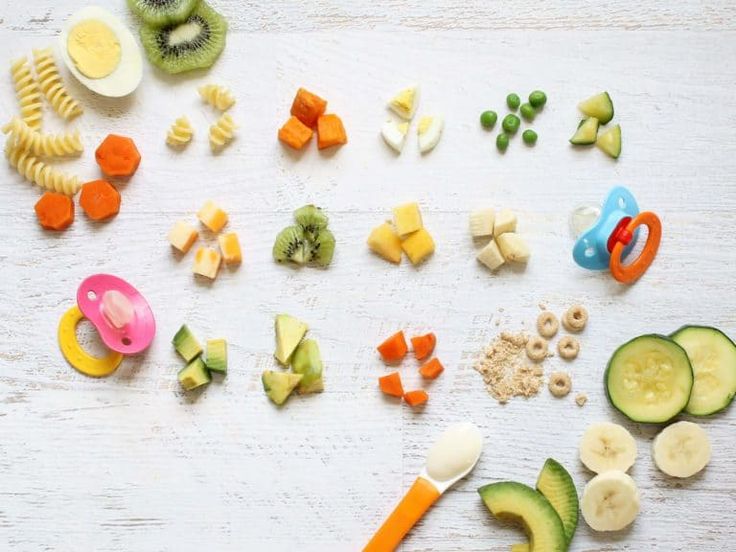 It may be worth postponing the introduction of complementary foods 1-3 weeks later.
It may be worth postponing the introduction of complementary foods 1-3 weeks later.
Before buying baby food, read the label carefully. The composition should not contain preservatives, flavor enhancers and palm oil. To restore the intestinal microflora, products with the addition of vitamins are suitable. It is important to look at the expiration date. And also choose content that is well absorbed at a certain age.
According to buyers and pediatricians, the following judgments about manufacturers can be distinguished:
- From inexpensive mashed potatoes - products of the company "Babushkino Lukoshko";
- Product for children of any age can be purchased from the manufacturer "Spelenok";
- Puree for children from 5 months is offered by the Tema company;
- Food from Gerber are suitable for those who appreciate the convenience of packaging;
- Premium products include mashed potatoes from the Semper brand;
- Natural purée without additional ingredients available from Hipp;
- Heinz offers the most vitamin purees;
- Food from Agushi and Hipp is recommended to stabilize the digestive system.



